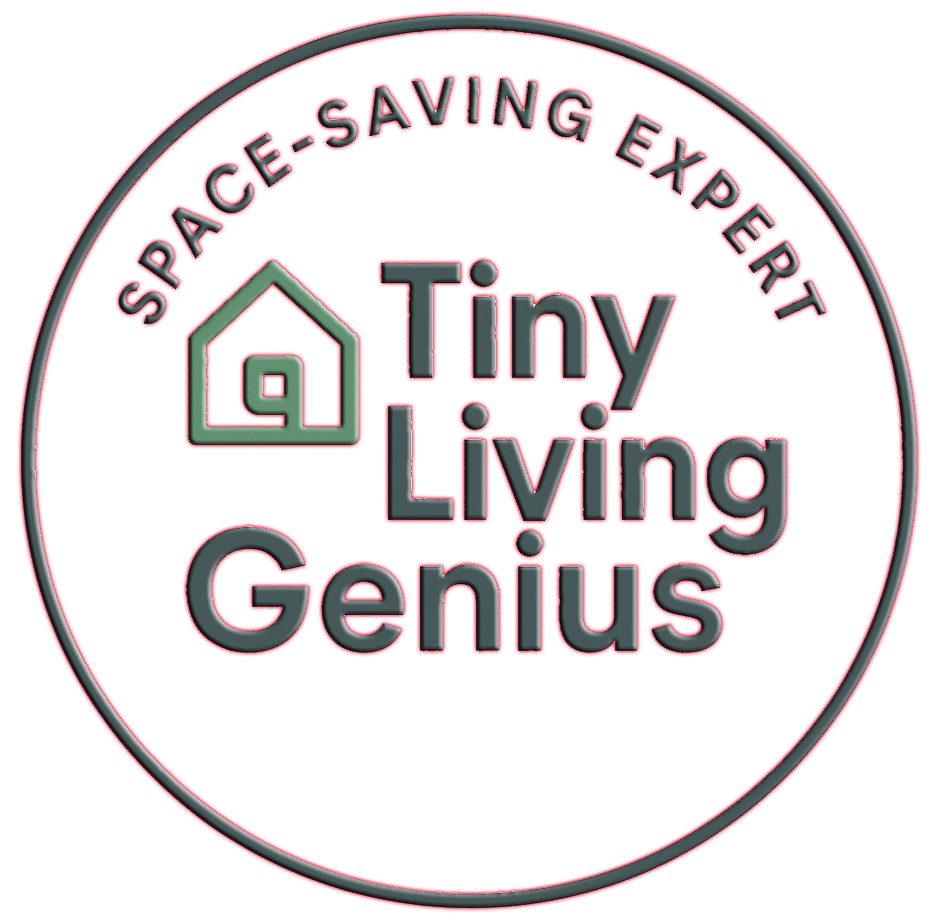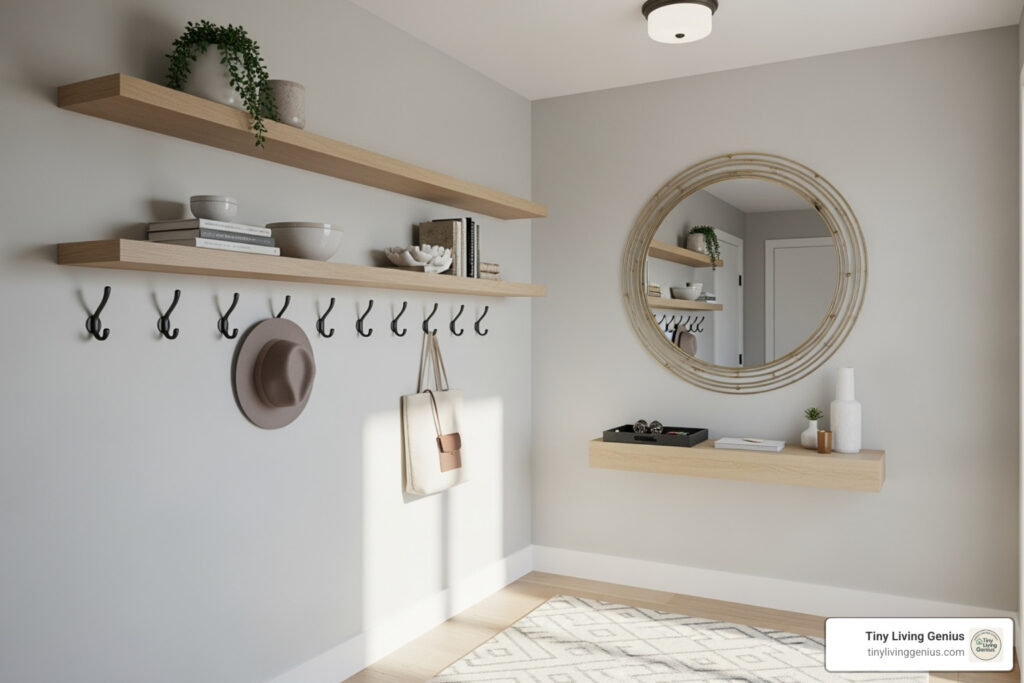Small Space Entryway Ideas: 7 Smart Strategies
Why Small Space Entryway Ideas Matter More Than You Think
Small space entryway ideas can transform a cramped, cluttered entrance into a functional and welcoming first impression. Here’s what works:
- Go Vertical – Use floating shelves, wall-mounted hooks, and pegboards to maximize wall space
- Choose Smart Furniture – Opt for slim console tables, storage benches, or wall-mounted pieces that serve multiple purposes
- Create Illusion – Add mirrors to reflect light and make the space feel larger
- Define the Zone – Use an area rug or bold paint color to separate your entryway from adjacent rooms
- Add Strategic Storage – Install wall bins, baskets, or a mail sorter for keys, shoes, and daily essentials
- Light It Right – Use wall sconces or pendant lights to brighten without taking floor space
- Personalize – Incorporate artwork, plants, or statement wallpaper to add character
Your entryway is where you transition between home and the outside world. But with limited square footage, it often becomes a dumping ground for clutter. The good news? Even small entryways can improve the organization, style, and flow of your home. The right approach can create a functional drop zone that makes life easier, even if your door opens directly into a living room.
The challenge isn’t the size—it’s maximizing what you have. A well-designed entryway sets the tone for your home, helps you stay organized, reduces daily stress, and creates a welcoming atmosphere for you and your guests.
I’m Ramy Saber, a Civil Engineer and founder of Tiny Living Genius, where I specialize in practical solutions for compact living. Through years of working with small-scale projects, I’ve developed strategies for small space entryway ideas that combine function with style—no matter how tight your quarters. Let me show you how to make your entryway work harder without taking up more space.
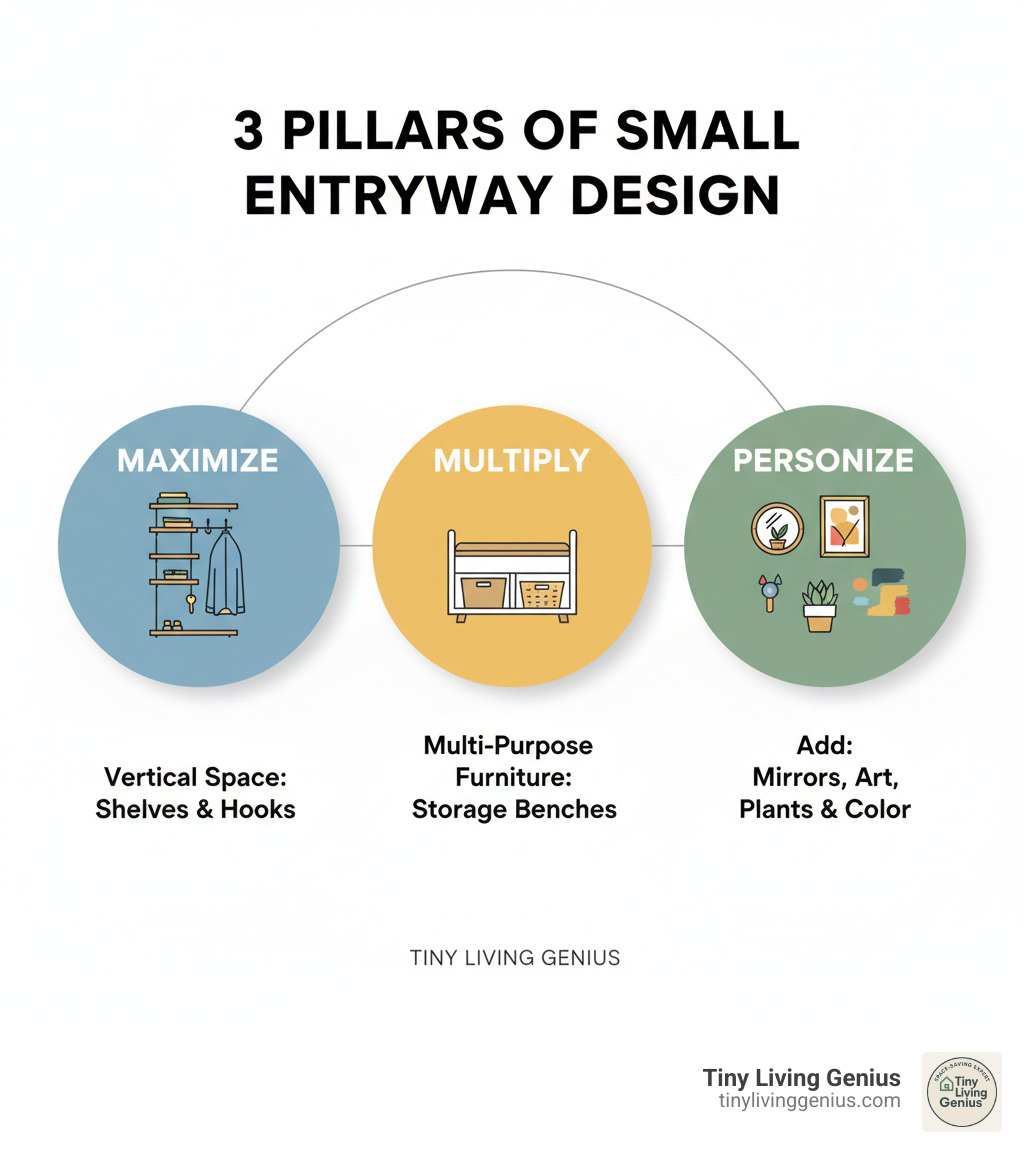
1. Go Vertical: Maximize Wall Space for Storage and Style
When floor space is tight, there’s only one direction to go: up. Your walls are prime real estate just waiting to be used, and tapping into that vertical space is one of the smartest small space entryway ideas you can implement.
Going vertical is also a clever design trick. Drawing the eye upward with shelves, hooks, and wall-mounted storage creates the illusion of height, making your entryway feel more spacious and airy.
The key is turning blank walls into hardworking zones that look intentional and stylish. For even more inspiration on making the most of your walls, check out our guide on Maximize Vertical Space in Small Spaces.
Floating Shelves and Ledges
Floating shelves are absolute game-changers for small entryways. They give you a place to stash keys, sort mail, and display personal touchesall without eating up an inch of floor space.
A sleek floating shelf by your door acts as a catch-all for keys and sunglasses so clutter stays under control from day one.
You can pair a shelf with a large mirror above it for a cohesive and stylish look that makes your entryway feel lighter. A simple floating shelf under a glamorous gold mirror is both functional and beautiful.
Even a narrow floating shelf can work like a mini console table, giving you just enough surface for a small vase or outgoing mail. For a custom touch, try anchoring your floating shelf with a painted arch detail on the wall. It makes the whole setup feel intentional and designed.
Creative Hooks and Racks
Skip bulky coat racks. Instead, think creative wall hooks and racks that keep your jackets, bags, and scarves organized without hogging precious floor space.
The options are surprisingly stylish. A small peg rack or a vintage-style accordion coat rack can handle jackets and purses with character.
For a modern look, staggered hooks at different heights create visual interest. For a touch of personality, try whimsical flower-shaped wall hooks.
Don’t overlook the space behind your door. A simple behind-the-door organizer can turn this forgotten nook into a vertical storage solution for shoes, bags, and hats. Every inch counts.
One important tip: always find the stud in your wall before mounting hooks or racks. You need solid support to handle the weight of heavy coats and loaded bags.
2. Choose Smart, Multifunctional Furniture
In a small entryway, every piece of furniture needs to earn its place. This is where multifunctional furniture becomes your best friend, combining storage with seating, or display surfaces with organization. Smart furniture choices make all the difference between a cramped mess and a functional, welcoming entrance.
For more inspiration on making your furniture work harder, check out our guide on Creative Furniture Solutions for Small Spaces. Now, let’s look at the top three multifunctional furniture types for entryways: the slim console table, the versatile bench, and wall-mounted units that free up floor space.
The Slim Console Table
A slim console table is a smart investment for a narrow entryway, providing a surface for keys, mail, or a small plant without making the space feel cramped. The key is to look for tables that are often just six to twelve inches deep.
Innovative two-legged console tables that anchor directly to the wall create the illusion of more space while still providing that essential landing spot.
Wall-mounted consoles take this concept even further by freeing up the floor entirely. A small wall-hugging dresser with drawers or a floating console keeps the look light and airy while adding storage.
The trick is choosing a piece that’s proportional to your spacetoo large and it becomes an obstacle; too small and it loses its functionality.
For a comprehensive guide on selecting furniture that actually fits your small space needs, explore How to Choose the Right Furniture for Your Small Space: A Comprehensive Guide.
The Versatile Bench
If you can only pick one piece of furniture for a small entryway, make it the versatile bench. It provides a comfortable spot to sit while you’re putting on shoes, a firm surface for bags, and hidden storage underneath for shoes or scarves.
A bench is a perfect multipurpose solution, offering seating, a drop zone, and shoe storage all in one.
Storage benches are particularly brilliant because they hide clutter while providing seating. Choose a chic bench with a tucked-away look that keeps shoes out of sight, or a sleek, mid-century-inspired bench that balances style and function.
Style options are endless, from a simple wooden bench with a cowhide throw for a farmhouse feel to a padded one with pillows for extra comfort. You can even find pale wood Scandi-style benches with integrated side tables.
Even a basic wooden bench offers ample space underneath for shoe storage. A small wooden bench paired with a wicker basket proves a cute entryway doesn’t have to break the bank.
If you’re really tight on space, consider swapping the bench for a simple chair. For an all-in-one solution, look for a freestanding unit that integrates a coat rack, seat, and shoe shelves. Don’t overlook charming telephone benches eitherthese vintage pieces offer a compact seat and a small surface, perfect for adding character.
For more guidance on mastering the art of selecting perfect pieces for your compact home, dig into The Ultimate Guide to Small Apartment Furniture: Smart Solutions for Tiny Living.
3. Master Illusion with Mirrors, Light, and Color
When you’re working with a tiny entryway, the secret isn’t always about adding moreit’s about creating the illusion of more. By strategically using mirrors, lighting, and color, you can trick the eye into seeing a space that feels larger and more welcoming.
These design tricks don’t require any floor space. Instead, they work with your walls, ceiling, and light. As many designers remind us, minimizing the number of colors in a small space creates a cohesive, expansive feel. But that doesn’t mean you can’t be bold!
The Magic of Mirrors
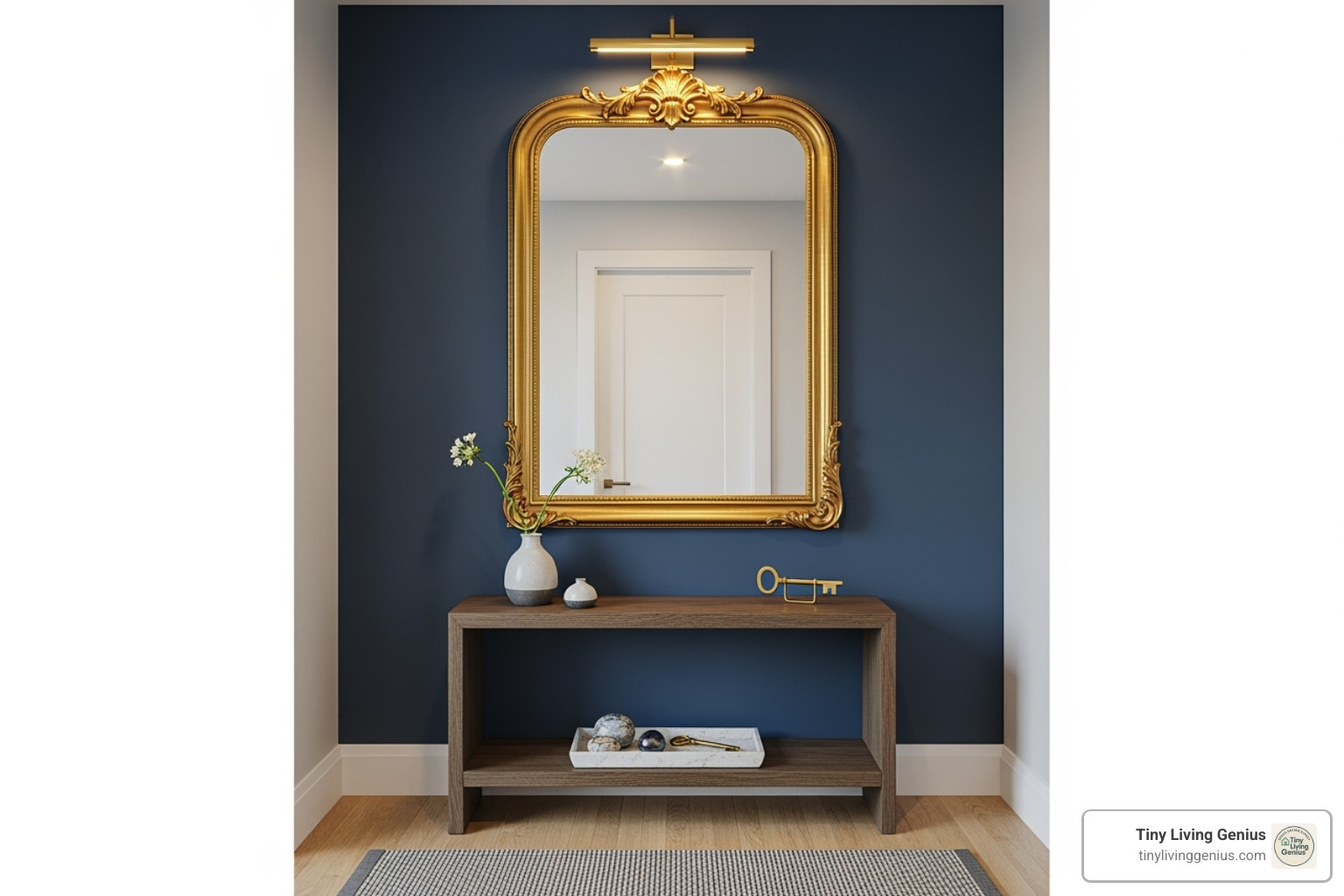
Mirrors are my favorite tool for small space entryway ideas. They are like magic wands for tiny spaces, instantly bouncing light around and creating the illusion that your entryway is twice its actual size.
The key is choosing the right mirror. A full-length mirror serves double duty: it makes your space feel larger and lets you check your entire outfit before heading out. This is far more practical than a smaller mirror that only shows your face.
For maximum impact, consider a statement mirror that becomes the focal point. A supersized wall mirror can double the perceived size of the space, and framed mirrored panels add architectural depth.
A custom mirror-table combo is another clever ideacombining a mirror with functional furniture is exactly what small spaces need.
The real magic happens when mirrors reflect light from nearby windows or doors. Position your mirror across from a light source to transform a dark entryway into a bright, airy welcome zone.
Strategic Lighting and Color for small space entryway ideas
Lighting can make or break a small entryway, especially a windowless one. The good news? Wall sconces and pendant lights provide illumination without eating up any floor space.
Cordless sconces on either side of a mirror eliminate the need for a table lamp. Pendant lights or flush mounts also work beautifully as focal points, drawing the eye upward and making your ceiling feel higher.
Now let’s talk about color. Many people assume small spaces need to be neutral, but bold paint colors and statement wallpaper can make a tiny entryway feel more intentional and designed.
Be brave with your choices. A narrow entryway brightened with sunny yellow paint, balanced with crisp white trim, can feel cheerful and expansive, not cramped.
Another approach is using patterned floor tile to define a small entryway and create visual interest. This works especially well when your door opens directly into another room, as the pattern signals “this is the entryway” without needing walls.
Don’t forget your ceiling! Painting the walls one hue and the ceiling a complementary color can connect disjointed hallways and add unexpected personality. These touches make your entryway memorable without taking up square footage.
Together with mirrors, strategic lighting and thoughtful color choices are the trifecta for making small entryways feel larger, brighter, and more welcoming.
4. Implement Creative and Stylish Small Space Entryway Ideas
Your entryway is your home’s handshake, the first glimpse of your personality that greets everyone. Even the tiniest entrance deserves to feel special and uniquely yours, and often the most charming entryways are compact ones where every detail counts.
The beauty of small space entryway ideas is that decor often pulls double duty as an organizational system. That vintage coat rack isn’t just prettyit’s keeping jackets off the floor. That gallery wall isn’t just artit’s drawing the eye upward. Even narrow hallways can make a serious impact with bold choices like statement wallpaper, striking tiled floors, or a show-stopping runner.
For more ways to infuse your compact home with personality while keeping it functional, explore our guide on Efficient Design for Small Spaces: Stylish Living Solutions for Small Spaces.
DIY Storage Solutions
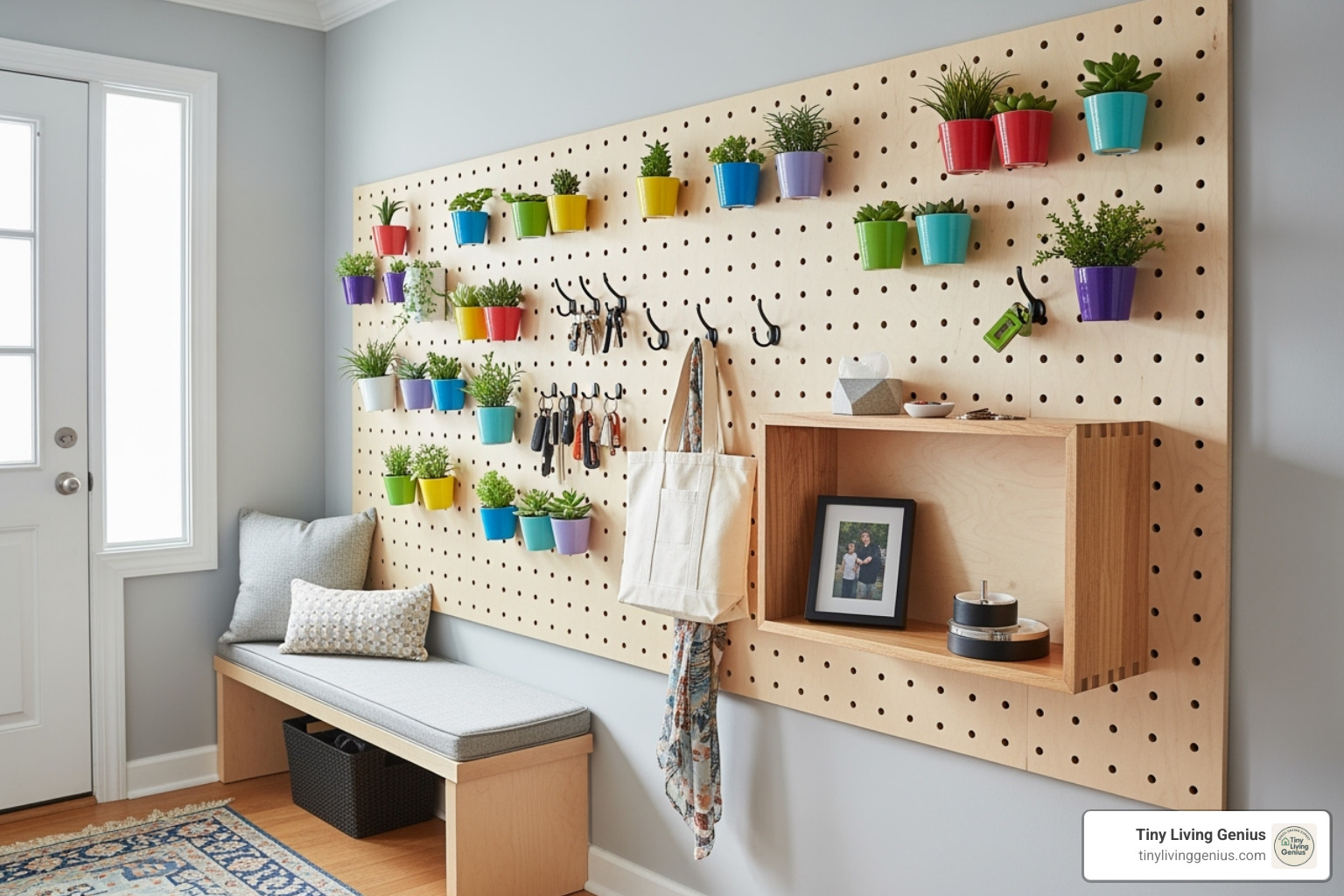
Budget-friendly and perfectly custom to your needs, DIY storage solutions are where creativity really shines. You don’t need expensive custom furniture to create a functional entrywayjust a little imagination.
Repurposing furniture is one of our favorite approaches. For example, transform a simple cabinet into a chic entryway storage piece. You can also hang wooden bins on the wall beside the door, adding wall hooks in between for a vertical solution that saves floor space.
The IKEA Hackers community is brilliant for DIY inspiration, with clever ideas for using the often-ignored space behind the door for shoe storage or turning tricky hallways into storage powerhouses with repurposed kitchen cabinets.
A DIY pegboard wall is another fantastic, budget-friendly optionyou can customize it with colorful accessories, add small plants, and rearrange hooks and baskets as your needs change. For even more clever ways to keep your compact home organized, check out our guide on Smart Storage Solutions for Small Spaces.
Add Personality with Decor
Now for the fun partmaking your entryway feel like you. This is where functionality meets personality, and where your home starts telling its story.
Artwork and photographs are powerful tools for small spaces. Narrow hallways are perfect for gallery walls because they encourage you to get up close with the art. Choose pieces that make you smile.
Fresh flowers and plants bring warmth and life to even the smallest entrance. A small vase of seasonal branches keeps your entryway feeling fresh and dynamic.
Don’t be afraid to go bold with your choices. A graphic floor runner can be daringthat’s what makes it work. Statement wallpaper, stenciled walls with a simple repeating pattern, or patterned floor tiles can define your entryway and create a memorable first impression.
The key is balancing personality with function. That decorative tray corrals keys, and those beautiful hooks keep coats organized. When every element serves a purpose and looks good, you’ve nailed the perfect small space entryway design.
Frequently Asked Questions about Small Entryways
We hear these questions all the time from readers trying to make the most of their compact entryways. Let’s explore the most common challenges and how to solve them!
How do I make a small entryway look bigger?
Making a small space entryway feel larger involves visual tricks that optimize light and space. The secret lies in how our eyes perceive depth and openness.
- Use mirrors. This is our #1 tip, and for good reason. A full-length mirror allows you to check your outfit while visually doubling the space. Mirrors bounce light and make the area feel larger.
- Choose light colors. Minimizing the number of colors in a space makes it feel larger. For a dark entrance, a light color palette is crucial for an open, airy feel.
- Draw the eye upward. Utilizing vertical space with wall hooks and shelving makes the walls seem taller and the room less cramped.
- Use floating furniture. Furniture that hovers above the floor creates an illusion of openness by leaving the floor visually uninterrupted.
- Light it well. Wall sconces or hanging lights can dramatically brighten a narrow or dark entryway. Sunny paint colors paired with good fixtures are transformative.
- Keep decor minimal. A few impactful items can make a statement without overwhelming the space. Thoughtful curation beats excessive decoration.
What’s the best furniture for a very narrow hallway?
Navigating a very narrow hallway requires thoughtful furniture choices that prioritize slim profiles and wall-mounted solutions that provide function without blocking your path.
- Floating shelves are perfect for dropping keys and mail without taking up any floor space.
- Slim console tables, especially “two-legged” designs that anchor to the wall, are game-changers for narrow spaces.
- A wall-mounted desk can turn a narrow nook into a functional area, often folding flat when not in use.
- Narrow benches provide seating and shoe storage where a traditional table or hall tree would be too bulky.
- Wall hooks are an absolute must in a smaller space. They offer storage for coats and bags with zero floor presence, making them the most space-efficient option.
How can I create an entryway when my door opens into the living room?
If your front door opens directly into a living area, you can still create a functional and welcoming zone with a few strategic moves.
- Use an area rug to define the zone. It provides an excellent visual cue to separate your “entryway” from the rest of the living room.
- Place a console table behind the sofa. If your sofa sits near the door, this slim table can act as your entryway drop zone without intruding on the main living space.
- Use a strategically placed bench. A bench against the wall closest to the door can serve as both a seating area and a landing strip for bags.
- Try a room divider screen. It can subtly separate the entryway area from the living room, creating a psychological boundary that helps establish your entryway zone.
Conclusion
Your entryway may be small, but as we’ve found together, it’s packed with potential. We’ve explored small space entryway ideas that transform cramped corners into functional, beautiful spaces—from vertical storage solutions to multifunctional furniture that serves double or triple duty.
We’ve seen how mirrors can expand your space visually, how the right lighting can brighten even the darkest hallway, and how a bold splash of color can turn a forgettable nook into a memorable first impression. Most importantly, we’ve seen how DIY creativity and personal touches can make your entryway uniquely yours, without breaking the bank.
Here’s what I want you to remember: a small entryway isn’t a design challenge to overcome—it’s an opportunity to get creative. When we accept smart strategies and think intentionally about every inch, we can create spaces that don’t just look good, but actually make our daily lives easier and more organized.
Your entryway sets the tone for your entire home. It’s the last thing you see before you face the world and the first thing that welcomes you back. Making it work for you, no matter how tiny, is worth the effort.
Ready to tackle more compact living challenges? Head over to Discover more tiny apartment tips at Tiny Living Genius for even more practical solutions and inspiration. Let’s continue making every square inch of your home count!
